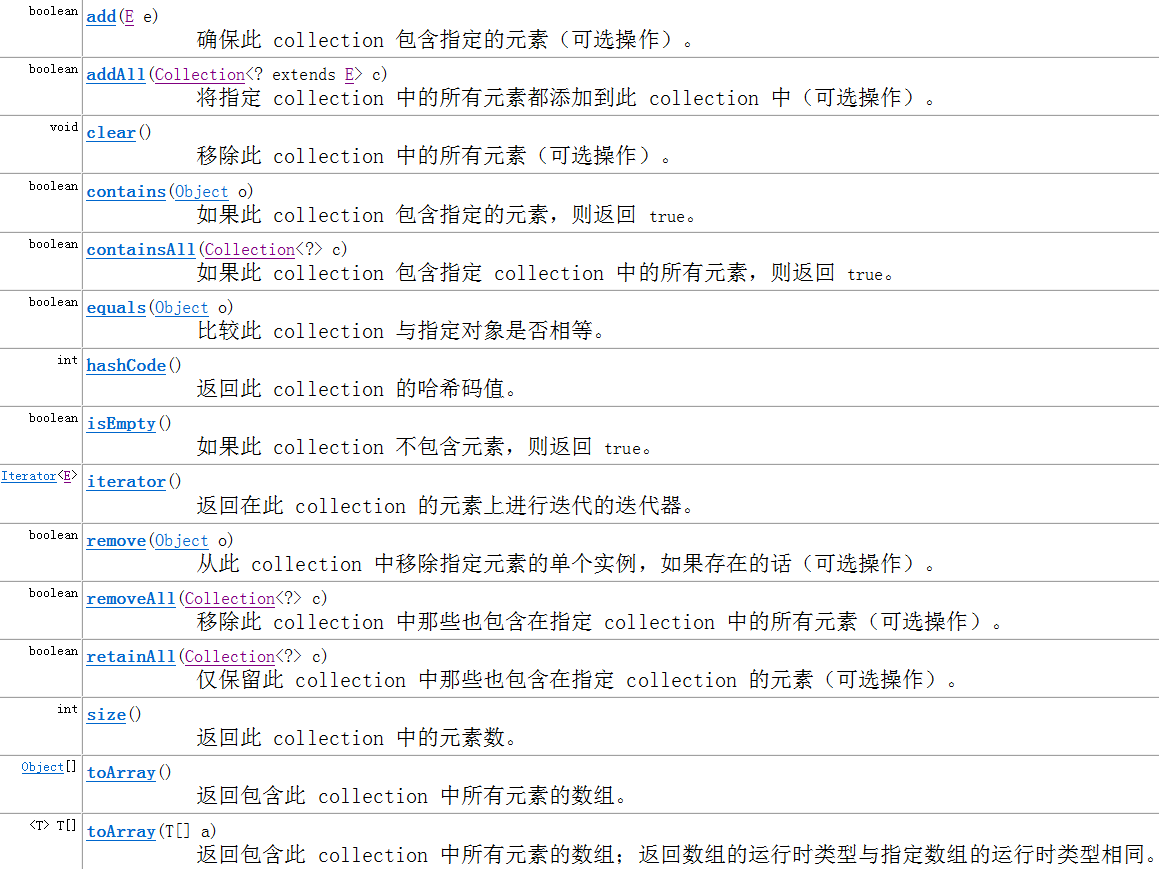Java 集合概述
Java 集合就像一种容器,可以把多个对象的引用放入容器中。
Java 集合类可以用于存储数量不等的多个对象,还可用于保存具有映射关系的关联数组
Java 集合可分为 Set、List 和 Map 三种体系
Set:无序、不可重复的集合
List:有序,可重复的集合
Map:具有映射关系的集合
在 Java5 之前,Java 集合会丢失容器中所有对象的数据类型,把所有对象都当成 Object 类型处理;从 Java5 增加了泛型以后,Java 集合可以记住容器中对象的数据类型。

Collection 接口
Collection 接口是 List、Set 和 Queue 接口的父接口,该接口里定义的方法既可用于操作 Set 集合,也可用于操作 List 和 Queue 集合:

1 public class TestCollections {
2 public static void main(String[] args) {
3
4 //1. 创建一个 Collection 接口的对象.
5 Collection collection = new ArrayList();
6
7 //2. Collection 重要方法说明:
8
9 /**
10 * 2.1 用于添加元素的:
11 * add()
12 * addAll()
13 */
14 Person p1 = new Person();
15 collection.add(p1);
16 collection.add(new Person());
17
18 Collection collection2 = new ArrayList();
19 collection2.add(new Person());
20 collection2.add(new Person());
21
22 collection.addAll(collection2);
23
24 System.out.println(collection.size());
25
26 /**
27 * 2.2 用于访问集合的方法:
28 * 获取集合的长度: size()
29 * 对集合进行遍历的方法: iterator() 可以得到对应的 Iterator 接口对象.
30 *
31 * Iterator: 迭代器
32 * ①. 获取 Iterator 接口对象:
33 * ②. 使用 while 循环和 Iterator 对象遍历集合中的每一个元素. 具体使用 Iterator 接口的
34 * hasNext() 和 next() 方法.
35 */
36 Iterator iterator = collection.iterator();
37
38 while(iterator.hasNext()){
39 Object obj = iterator.next();
40 System.out.println(obj);
41 }
42
43 /**
44 * 2.3 移除集合中的元素:
45 * remove(): 移除某一个指定的对象. 通过 equals() 方法来判断要移除的那个元素在集合中是否存在. 以及是否能够成功移除.
46 * removeAll()
47 * clear(): 使集合中的元素置空.
48 */
49 // collection.clear();
50
51 // boolean result = collection.remove(p1);
52 // System.out.println(result);
53 //
54 // result = collection.removeAll(collection2);
55 //
56 // System.out.println(collection.size());
57
58 /**
59 * 2.4 用于检测集合的方法
60 * retains()
61 * retainsAll()
62 * isEmpty()
63 *
64 */
65 System.out.println(collection.contains(new Person()));//false
66 System.out.println(collection.contains(p1));//true
67 System.out.println(collection.containsAll(collection2));//true
68
69 System.out.println(collection.isEmpty()); //false
70 // collection.clear();
71 System.out.println(collection.isEmpty()); //true
72
73 /**
74 * 2.5 其他方法
75 * toArray(): 返回这个集合对应的数组对象
76 * **T [] toArray(T[]): 涉及到泛型, 后面再说.
77 *
78 * equals(): 比较两个集合是否相等.
79 * hasCode():
80 *
81 */
82 Object [] objs = collection.toArray();
83 System.out.println(objs.length); //4
84
85 Person p2 = new Person();
86
87 Collection collection3 = new HashSet();
88 collection3.add(p1);
89 collection3.add(p2);
90
91 Collection collection4 = new HashSet();
92 collection4.add(p2);
93 collection4.add(p1);
94
95 System.out.println(collection3.equals(collection4));
96
97 /**
98 * 使用增强 for 循环的方式来对集合进行遍历
99 */
100 for(Object obj: collection){
101 System.out.println(obj);
102 }
103 }
104 }
Iterator 接口
Iterator 接口主要用于遍历 Collection 集合中的元素,Iterator 对象也被称为迭代器。
Iterator 接口隐藏了各种 Collection 实现类的底层细节,向应用程序提供了遍历 Collection 集合元素的统一编程接口
Iterator 仅用于遍历集合,Iterator 本身并不提供承装对象的能力。如果需要创建 Iterator 对象,则必须有一个被迭代的集合。
